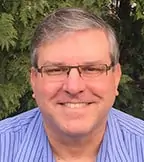


Thank you for your friendship, your business, and the opportunity to serve you.
The Pennsylvania Department of Environmental Protection (DEP), Bureau of Waste Management, has awarded SCS Engineers (SCS) a contract to provide recycling and organics management technical assistance to local governments throughout the state. Brent Dieleman, SCS’s Project Manager, has years of experience administering these types of programs for the Solid Waste Association of North America.
Pennsylvania ratified “Act 101” in 1988 to manage waste and promote recycling across the Commonwealth. The DEP developed the Recycling Technical Assistance Training Program to help local governments comply with Act 101 by improving and expanding their collection and diversion programs. SCS will help administer and provide technical assistance to this Program. The comprehensive support provides for curbside and drop-off recycling programs, solid waste planning, public education, materials processing, equipment, technical training, environmental protection programs, and organics management.
Additionally, local governments can apply for technical assistance, up to $7,500 per applicant, to help expand and improve their recycling and organics management systems. SCS will work with applicants to assess their needs and refine the scope of their project. Once DEP approves a technical assistance project, SCS will then provide specialized, tailored training to each recipient.
SCS will help each grant recipient address the unique issues and challenges facing their program including, composting, collections, incentive-based programs such as pay-as-you-throw, and siting of new facilities. SCS anticipates providing technical assistance for up to 30 local governments annually.
DEP is tasking SCS with helping them find ways to further promote the Program across the Commonwealth and enable local governments to benefit from it. SCS anticipates presenting the initiative to local landfill owners and operators at a seminar in Harrisburg, Pennsylvania on June 9, 2017.
“In recent years Pennsylvanians have recycled nearly 17 million tons of waste, which removed almost 16 million tons of carbon dioxide emissions from the air. That is equivalent to saving the electricity used in 2.18 million American homes per year or taking 3.34 million passenger vehicles off the road for one year,” said Brent Dieleman. “We’re facilitating the DEP to help local governments efficiently expand their recycling programs.”
SCS Engineers met a tight, non-negotiable regulatory deadline to get the new plant on-line while meeting non-toxic effluent standards.

Everyone enjoys before and after pictures; just look at the results New Hanover County’s program is producing. This and other County programs are helping this North Carolina county reduce reliance on landfill disposal while creating a comprehensive and sustainable solid waste management system that is protective of the environment.
In 2016 a new wastewater treatment plant was commissioned at the New Hanover County Landfill. The new facility processes approximately 65,000 gallons per day (GPD) of leachate using state-of-the-art ultrafiltration (UF) and reverse osmosis (RO) technologies to meet or exceed federal and state treatment standards.
The raw leachate is pre-treated in an existing aerobic lagoon followed by a sequencing batch reactor (SBR) to reduce organic constituents. The pretreated effluent then flows into the membrane system. Using state-of-the-art membrane filtration technology, including ultrafiltration (UF) pictured at lower left, and a reverse osmosis (RO) system, pictured lower right, to produce crystal clear, effluent discharged to an upper tributary of the Cape Fear River.
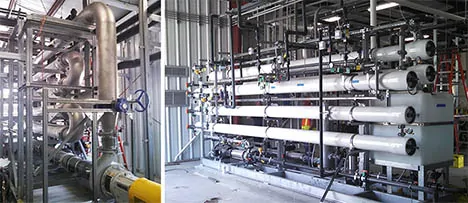
The new facility can process 75,000 GPD and the Wastewater treated through the new system meets state Drinking Water standards for quality.
Tough surface water discharge standards and predictable performance in cold weather drove the design to use UF/RO systems. The results are impressive; metals including arsenic are BDL, ammonia <0.2 ppm, and TSS < 2 ppm. The system produces approximately 13,000 GPD of RO concentrate that is pumped to the working face and safely disposed of in the landfill. The County has certified operators that have played a big role in getting the plant shaken down and running smoothly.
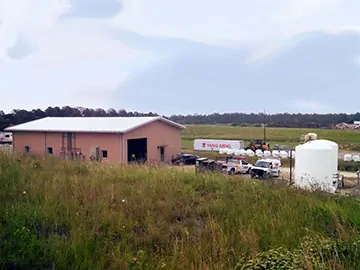
“New Hanover County is an industry leader in adopting proven technologies to better manage solid waste, and protect the environment. This kind of planning and approach can benefit many other public works departments,” stated Bruce Clark, PE, BCES, LEED AP®, and SCS Engineers National Expert on Waste Conversion.
As Joe Suleyman, the County’s Environmental Management Director put it, “Let’s face it – people move to New Hanover County because they love to be in, on, or near the water. Our technical staff is composed of very talented folks who have environmental science and biology backgrounds. They believe in what they’re doing to help protect our delicate coastal environment, and this state-of-the-art system is a huge stride towards meeting our own expectations and those of the citizens we serve.”
See more case studies, services, and professionals on the SCS Engineers – Liquids Management Website
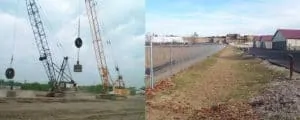
Historic fill is common on properties that were once rural and have become prime redevelopment sites as communities expanded. The fill may include contaminated materials like foundry sand, ash, demo and construction debris, and even municipal waste. In the past, these materials were used to fill wetlands or change the grade of the property before initial development. Today regulations have evolved, and state agencies require property owners to manage these materials appropriately during redevelopment. Also, particular types of historic fill are often not robust enough to structurally support your new building.
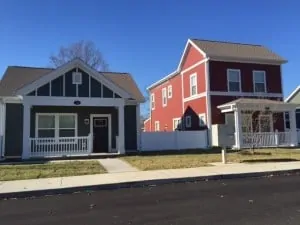
There are many different kinds of fill materials – each with different physical properties and different potential contaminants. Knowing what is on your property before you start designing the site layout, and certainly, before you start digging, will help you plan your project to save time and money, and to receive state agency approval.
Before You Buy
The more you know about the property and the earlier you know it, the better prepared you will be to make decisions about how best to protect yourself from potential environmental liabilities and prepare for the environmental and geotechnical issues that historic fill can cause. Since every property is unique, the first thing you need to do is gain a thorough understanding of the property’s history and past use. Invest in a comprehensive Phase 1 Environmental Site Assessment (ESA). Consider it a starting point for clues about the possible types and amounts of historic fill which may be present on the property.
If the results of the Phase 1 ESA warrant it, conduct a Phase 2 ESA and geotechnical study to collect soil, fill, groundwater, and soil vapor samples. The Phase 2 ESA and geotechnical studies will help you understand if fill and contaminants are present and the best options for addressing them during the development planning stage.
Historic fill on a property is no longer the impediment to development that it once was. Take these steps to get ahead of potentially contaminated historic fill, and keep your project on time and budget.
By testing early, performing a proper geotechnical evaluation, and incorporating design adaptations where needed, you can successfully develop projects with historic fill within your schedule and without breaking your budget.
SCS professionals are available to answer questions or concerns you may have pertaining to commercial, residential, or private development on brownfields – we provide remediation, brownfields, and Environmental Due Diligence services nationwide. Contact or one of our experts.

Ray Tierney, PG, is a Vice President of SCS Engineers and one of our National Experts on Sustainability. He has 30 years of experience in environmental and sustainability engineering and has helped a wide range of organizations control and reduce their legacy environmental impacts and liabilities, lower their costs, obtain grants and permits to expand, and implement cost-saving practices. Ray serves the Midwest region and projects throughout the U.S.
JohnTabella, PG, LEED AP®, is SCS Engineers National Expert for Environmental Due Diligence and for Federal Services. In this capacity, he oversees all aspects of environmental services opportunities and projects primarily throughout the eastern seaboard and supports on opportunities and projects throughout the U.S.
Floyd Cotter specializes in solid waste management projects. His project work involves all areas of solid waste management including planning, permitting, transportation, landfill design, construction, and monitoring. Floyd is also experienced in general civil engineering, construction oversight, environmental site assessments, closure and post-closure plans, and permit and contract document preparation. Floyd is located in the Central region.
Randy Bauer has nearly 3 decades of experience conducting environmental site assessments, subsurface investigations, groundwater monitoring programs, soil and groundwater remediation, and geotechnical investigations at industrial hazardous waste and solid waste facilities. Randy is available to answer questions on the western seaboard.
An ammonia system that has accurate valve tags, gives detail within facility documentation of SOPs, verifies the accuracy of facility P&IDs, and provides safety measures for operators and contractors for exercising the appropriate valves on the system. Standard operating procedures with proper valve tag placement also helps prevent human error.
Remember, you have the potential to improve safety and minimize risk. A strong training program and accurate operating procedures making a positive impact on worker safety and system operations.
Imagine that one of your employees comes and tells you that a 100-gallon spill just took place at your facility and it is flowing swiftly toward a storm sewer on your property.
Suddenly all eyes are on you. What you do next will show your leadership and skill at addressing the issue and limiting the company’s liability. Are you ready to be the hero, or is spill preparedness the one item that just keeps slipping down your to-do list?
Use the techniques recommended in Chris Jimieson’s latest article to make your spill response training engaging and interactive for staff handling oil. Spill preparedness becomes part of your routine and you’re ready to be the hero if a spill occurs.
Improve Your Spill Preparedness
SCS Management Services™ helps many of our clients’ incorporate economic planning, financial analysis, and feasibility studies into their master planning and have requested copies of our articles. All can be found and filtered by topic area, and we are always ready to help you find the information you need.
Our articles may be printed or shared using the icons on the left navigation bar. Or, you may share or email this page to keep it handy. SCS respects your privacy; we do not monitor or collect your email address or information.
Contact Vita Quinn for more information. Ms. Quinn is SCS Engineers’ National Expert on Solid Waste Finance and Rate Studies. She has 12 years of experience as a financial analyst and management consultant. She has extensive experience working for local government and has developed financial sustainability solutions for various general governments, special revenue funds, and utility enterprise funds. Ms. Quinn has an MBA in Finance and a Bachelor’s Degree in International Economics.
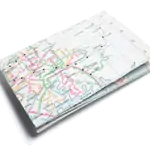
Residential Automated Collection Makes Sense for Idaho Falls
The Nuts and Bolts of Implementing a Residential Automated Collection Program
Conducting a Rate Analysis as Part of a Master Plan Study in Killeen, Texas
https://www.scsengineers.com/scs-articles/conducting-a-rate-analysis-as-part-of-a-master-plan-study/

Conducting Solid Waste Rate Studies and Business Plans
https://www.scsengineers.com/conducting-solid-waste-rate-studies-and-business-plans/
Get a Firm Handle on Solid Waste Costs to Optimize Performance
https://www.scsengineers.com/get-a-firm-handle-on-solid-waste-costs-to-optimize-performance/
Cash Flow Analysis Forestalls Long-Term Debt
Is Privatization the Answer? You Need to Consider Several Factors Before Making the Decision for Solid Waste Services
https://www.scsengineers.com/publications/articles/page/11/
Developing a Strategic Business Plan for Your Agency
Economic Feasibility 101 – Understanding the Tools of the Trade
Assessing a Solid Waste Agency’s Financial Health
Are Your Rates Correct? Collection and Disposal Rate Studies are a Valuable Tool
Integrating Financial Analysis into Solid Waste Operations Planning

Recycling Trends in the United States
https://www.scsengineers.com/scs-articles/6555/

Anaerobic Digester Economics
Give SCS a call or send an email to if you have questions. Find your local office here: https://www.scsengineers.com/locations/. Visit our Solid Waste Planning Services page for additional information, articles, whitepapers, and case studies.
Over years of working on operations and maintenance of landfill gas collection and control systems and leachate management systems, SCS found that too many times data is collected and no one has the time to review and analyze it for improved decision-making.
As an industry-wide issue, SCS developed systems to streamline the process using technology and our field expertise to help perform routine and sometimes complex data analysis and to automatically push reports and alerts to operators, engineers, and project managers.
The improvements are dramatic; by removing human error from reviewing pages of data we now focus our time and energy on what really matters, using what the data tells us to make informed decisions. Let’s put the technology into the context of everyday operations – identify, troubleshoot, and solve landfill gas and leachate challenges.
This SCS paper illustrates several sites using integrated systems for data collection and analysis and how they are used to identify, troubleshoot, and solve real problems in an effective and efficient manner.
Privately share this article using the email icon on the left navigation bar. Print the article using the Download icon just under the article, or your browser commands.
About the Authors:
David P. Hostetter, PE, Denver, Pennsylvania
Phil Carrillo, Huntington Beach, California
Darrin D. Dillah, Ph.D., PE, BCEE, Reston, Virginia
By October 17, 2016, coal combustion residual (CCR) landfills subject to the Environmental Protection Agency’s (EPA) CCR regulations published at 40 CFR 257, Subpart D, also known as the Federal CCR Rule, were required to prepare a Run-on and Run-off Control System Plan. Your plan documents how you have designed and constructed your landfill to prevent storm water from running onto or off the active landfill. But, what’s next?
Have you addressed run-on and run-off control system operation and maintenance?
Spring is a great time to review your storm water control plans and, more importantly, your storm water controls. The snow is gone now and spring rains are on their way, so knowing that your storm water controls are working and water is going where you intend it to go should be part of your spring inspection routine. Don’t want to waste money managing clean storm water with your leachate management system, or put your facility at risk by allowing unintended runoff from the landfill. A few basic inspection tasks will help ensure you don’t.
A spring run-on and run-off control system inspection should include the following:
Don’t let spring rains catch you off guard. SCS Engineers can help you assess the effectiveness of your run-on and run-off control systems. For help conducting storm water inspections as well as studies to review leachate, contact water, and storm water minimization and reuse opportunities, or for questions about run-on and run-off control system inspections or more information about minimization and reuse studies, please contact:
Mike McLaughlin, PE, Senior Vice President
Eric Nelson, PE, Vice President
Steve Lamb, PE, Vice President
Kevin Yard, PE, Vice President
Or, contact your local SCS Engineers office.
Learn more about the author Eric Nelson:
Eric J. Nelson, PE, is a Vice President of SCS Engineers and our National Expert for Coal Combustion Residuals (CCR). He is an experienced engineer and hydrogeologist. His diverse experience includes solid waste landfill development, soil and groundwater remediation, and brownfield redevelopment.
Mr. Nelson has worked with utility clients to complete numerous projects for dry CCR landfills, CCR ponds, and general environmental monitoring and compliance. He has been involved with CCR landfill projects that include feasibility analyses and permitting of landfill expansions; hydrogeologic and geotechnical site investigations; site design and operating plans; soil borrow source identification and permitting; liner and final cover construction liner, cover, and storm water management repairs. He has worked with utility clients to evaluate, plan, permit and complete CCR pond repairs and closures.
Mr. Nelsons environmental monitoring and compliance experience includes groundwater monitoring; oil containment design and construction; and Spill Prevention, Control, and Countermeasure (SPCC) planning. This diverse project experience has provided him the opportunity to work on challenging and innovative projects that have included design and permitting for wetland and stream mitigation, identifying and avoiding former underground mines during site design, and assessing the feasibility of installing a solar photovoltaic system on a closed CCR landfill.
Mr. Nelsons additional areas of expertise include remedial action planning, cost estimating, bidding and construction documents, and construction quality assurance. He has worked with electric utilities, solid waste facility owners/operators, and private property owners and developers.
The Wisconsin Department of Natural Resources (WDNR) initiated a Waste and Materials Management (WMM) Study Group to provide constructive feedback on policy and technical issues. There are also five subgroups assigned to research selected topics and develop recommendations for presentation to the full group.
The study group and subgroups include a mix of regulators, industry representatives, environmental group representatives, researchers/professors, and consultants.
The WMM study group has five subgroups working on along with resources related to the area of study:
Get Involved
Feel free to contact Tom Karwoski or Betsy Powers for more information; active study group members ready to answer your questions and help you get engaged in the WMM.

